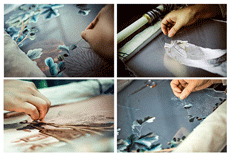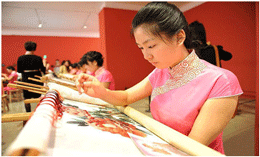Custom Embroidered Patches
Embroidered patches are a universal part of life, both in the United States and around the world. But do you know about the history of Chinese Embroidered Patches? Chinese embroidery has a long history dating back to the Neolithic Era and also become world-famous since the opening of the Silk Road during the Han Dynasty. The following will introduce you to China’s four most distinguished embroidered styles.
1. Su Xiu 苏绣
Suzhou embroidery is one of China’s outstanding national traditional crafts. It is the general name for embroidered products in the Suzhou area. Its birthplace is in Wuxian, Suzhou, and has now spread to Wuxi and Changzhou. Embroidery and sericulture, silk cannot be separated, so embroidery, also known as silk embroidery. The Qing Dynasty was the heyday of Suzhou embroidery. It was indeed a genre and a famous show. Suzhou embroidery has a unique style with beautiful designs, clever ideas, meticulous craftsmanship, lively stitches, and elegant colors.

2. Xiang Xiu 湘绣
Xiang Xiu, one of China’s four famous embroiderers, has long been loved by people at home and abroad. And over time, the value of Xiang embroidery, which is China’s intangible cultural heritage, will only increase in value without falling. In 1972, in the silk fabrics unearthed from the tomb of the Mawangdui No. 1 in Changsha more than 2,000 years ago, there were precious embroideries such as the “Longevity of Longevity” and the “Yao Diyun Embroidery”. One of them is less than one or two. It can be described as an embroidered treasure. The high technology is evident. The needles used for these embroidery products, such as bead needles and string needles, are basically the same as the current Xiang embroidery needles. Therefore, Xiangxiu has a long history.

3. Shu Xiu 蜀绣
Shu Xiu, also called Chuan Xiu, Sichuan embroidery comes from areas around Chengdu, Sichuan Province. Shu Xiu is the oldest embroidery style in the history of Chinese embroidery. The raw materials for embroidery are silk and colored silk. Its craftsmanship is exquisite and exquisite. Embroidery focuses on splicing, exquisite coloring, and local flavor. They are often used for quilt covers, pillowcases, clothing, shoes, and painted screens.
Tips: Today, Shu Xiu is mainly found in quilt covers, pillowcases and cheongsams. An exquisite Shuxi suture exquisite cheongsam can be used as a good souvenir.

4. Yue Xiu/Guang Xiu (粤绣/广绣)
Yue Xiu is crafted in areas around Chaozhou and Guangzhou Province. Yue Xiu is highly regarded for its full composition of intricate but symmetrical patterns, vibrant colors, varied stitches, and a defined weave. Since Yuexiu craftsmen are all males, compared with the other three kinds of embroidery styles, the early Yuexiu crafts were not so delicate.
Tips: Beijing Palace Museum has the largest collection of Yuexiu.

In the 19th century, the first embroidery sewing machine was born, The Person who introduced the embroidery machine is called Alphonse Kursheedt. He imported twelve new embroidery handlooms to create a mechanized process. After later, inspired by the sewing machine, Isaak Groebli created the Embroidered machine, which uses a continuous thread of needles and shuttles. Today, computerized machines use the “digital” mode to create embroidery designs. They can create a large number of embroidered patches for sports teams, companies, uniforms, etc.

For many years, the most common clothing or decorative patch is an embroidered patch. However, over time, society has gained more creativity through the production process and introduced newer ways to create embroidered patches. At GS-JJ.com, we offered 3 types of Embroidered Patches as follows:
100% Embroidered Patches
100% embroidered patches, all of the twill backings is covered in thread. Because of its excellent quality and appearance, The 100% Embroidered Patch is our highest quality patch we offer, As Customers choose thread colors for the entire patch which contains no visible twill.

75% Embroidered patches
75% Embroidery patches mean more than 50% but less 100% of the surface area of a patch will be embroidered in thread. 75% embroidered patches allow the featuring of both larger and centered embroidery design elements. The embroidered areas highlight the difference between height and texture both the twill backing, which adds a distinctive look and the sturdiness of the item for custom patches.

50% Embroidered Patches
50% embroidered patches mean the embroidery covers 50% or less of the surface area of the twill backing. 50% embroidered patches is good for simpler artwork or text-only designs, like Name patches (patches that display name or position of the user. E.g. “Trevor” or “President”), since the large amount open space is great for showcasing your message and keeps the patch simple, classic, clean look.

At GS-JJ.com, we are always giving you all the best. Our Custom Patches System can help you create the perfect Embroidered patches for your needs and have the lowest 40% off. To find out more, call us toll-free at 18888644755 or email us info@gs-jj.com.

I would like to extend my gratitude to a writer for sharing a comprehensive history about chinese embroidered patches in your write-up. Especially I love Shu Xiu embroidery pattern definitely I will try embroidered similar to this for my bedsheet and pillows.
Wow, It’s a piece of excellent information you share on this blog. Create an embroidered patches information is really helpful. Great information. Thanks!
I was in Shaghai last week. I looked for a travel patch for that city and found nothing! Several shops told me they could make several hundred for me but had nothing on hand. Nothing signifying anything Chinese.